2020人教版小学六年级英语下册时态
- 格式:docx
- 大小:23.50 KB
- 文档页数:8
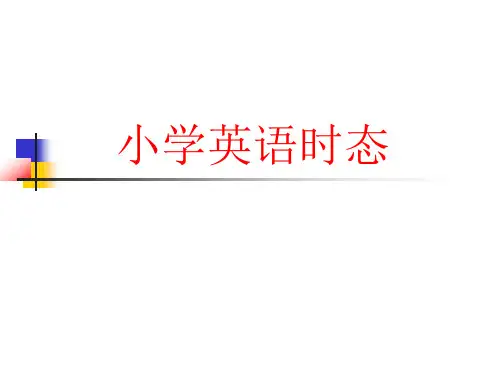
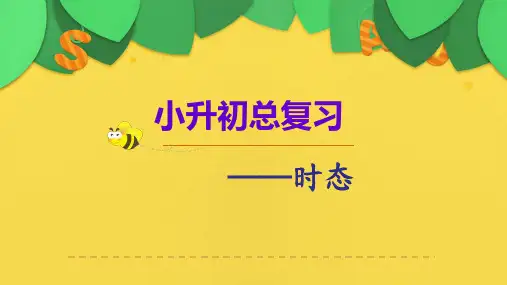
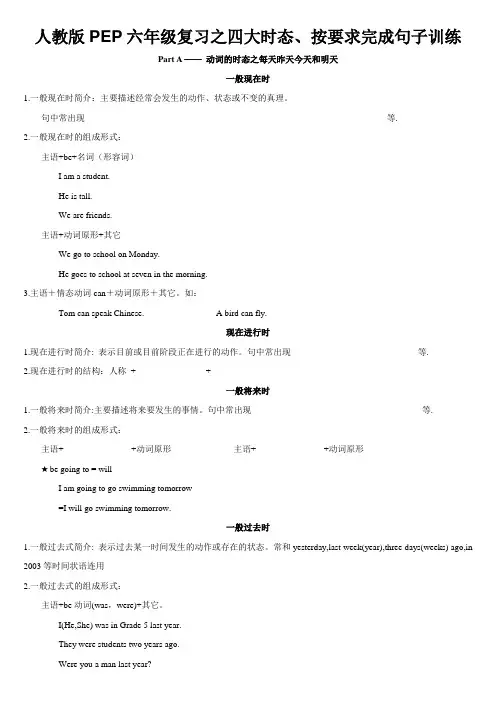
人教版PEP六年级复习之四大时态、按要求完成句子训练Part A ——动词的时态之每天昨天今天和明天一般现在时1.一般现在时简介:主要描述经常会发生的动作、状态或不变的真理。
句中常出现____________________________________________________________________等.2.一般现在时的组成形式:主语+be+名词(形容词)I am a student.He is tall.We are friends.主语+动词原形+其它We go to school on Monday.He goes to school at seven in the morning.3.主语+情态动词can+动词原形+其它。
如:Tom can speak Chinese. A bird can fly.现在进行时1.现在进行时简介: 表示目前或目前阶段正在进行的动作。
句中常出现____________________________等.2.现在进行时的结构:人称+ _______________ + _______________一般将来时1.一般将来时简介:主要描述将来要发生的事情。
句中常出现______________________________________等.2.一般将来时的组成形式:主语+ _______________+动词原形主语+ _______________+动词原形★be going to = willI am going to go swimming tomorrow=I will go swimming tomorrow.一般过去时1.一般过去式简介: 表示过去某一时间发生的动作或存在的状态。
常和yesterday,last week(year),three days(weeks) ago,in 2003等时间状语连用2.一般过去式的组成形式:主语+be动词(was,were)+其它。

一.时态语法(一)一般过去时态概念:一般过去时态表示在过去的某个时间发生的动作或存在的状态,常和表示过去的时间状语连用。
例如yesterday, last weekend ,last Saturday ,等连用。
基本句型:主语+动词的过去式+其他。
例句:——What did you do last weekend?你上周做什么了?——I played football last weekend.我踢足球了。
规则动词过去式的构成⒈一般在动词原形末尾加-ed。
例如:play—played⒉词尾是e的动词直接加-d。
例如:dance—danced⒊末尾只有一个辅音字母的重读闭音节词,先双写这个辅音字母,再加-ed。
例如stop(停止)--stopped⒋结尾是“辅音字母+y”的动词,变“y”为“i”,再加-ed,例如:study--studied一些不规则变化的动词过去式am/is—was are—were go—went swim—swam fly—flew do—did have —had say—said see—saw take—took come—camebecome—became get—got draw—drew hurt—hurt read—read tell—told will —would eat—ate take—took make—made drink—drank sleep(睡觉)—sleptcut(切)--cut sit(坐)—sat begin(开始)—began think—thought find—found run(跑)---ran buy—bought win—won giv e(给)—gave sing—sang leave—left hear(听)--heart wear—wore(二)一般现在时态概念:一般现在时态表示包括现在时间在内的一段时间内经常发生的动作或存在的状态,表示习惯性或客观存在的事实和真理。
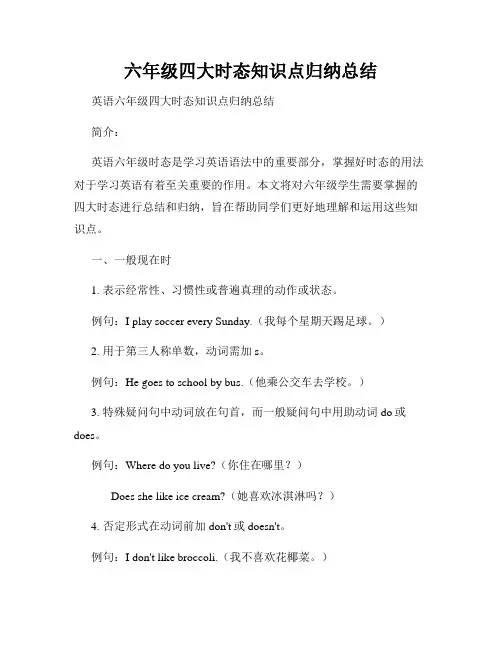
六年级四大时态知识点归纳总结英语六年级四大时态知识点归纳总结简介:英语六年级时态是学习英语语法中的重要部分,掌握好时态的用法对于学习英语有着至关重要的作用。
本文将对六年级学生需要掌握的四大时态进行总结和归纳,旨在帮助同学们更好地理解和运用这些知识点。
一、一般现在时1. 表示经常性、习惯性或普遍真理的动作或状态。
例句:I play soccer every Sunday.(我每个星期天踢足球。
)2. 用于第三人称单数,动词需加s。
例句:He goes to school by bus.(他乘公交车去学校。
)3. 特殊疑问句中动词放在句首,而一般疑问句中用助动词do或does。
例句:Where do you live?(你住在哪里?)Does she like ice cream?(她喜欢冰淇淋吗?)4. 否定形式在动词前加don't或doesn't。
例句:I don't like broccoli.(我不喜欢花椰菜。
)He doesn't play the guitar.(他不弹吉他。
)二、一般过去时1. 表示过去某个时间发生的动作或状态。
例句:I watched a movie yesterday.(我昨天看了一部电影。
)2. 动词过去式一般在动词后加-ed,但也有一些不规则动词。
例句:She ate an apple for breakfast.(她吃了一个苹果作早餐。
)3. 特殊疑问句和一般疑问句中用助动词did。
例句:What did you do yesterday?(昨天你做了什么?)Did they go to the park?(他们去公园了吗?)4. 否定形式在动词前加didn't。
例句:I didn't swim in the lake.(我没有在湖中游泳。
)They didn't finish their homework.(他们没有完成作业。
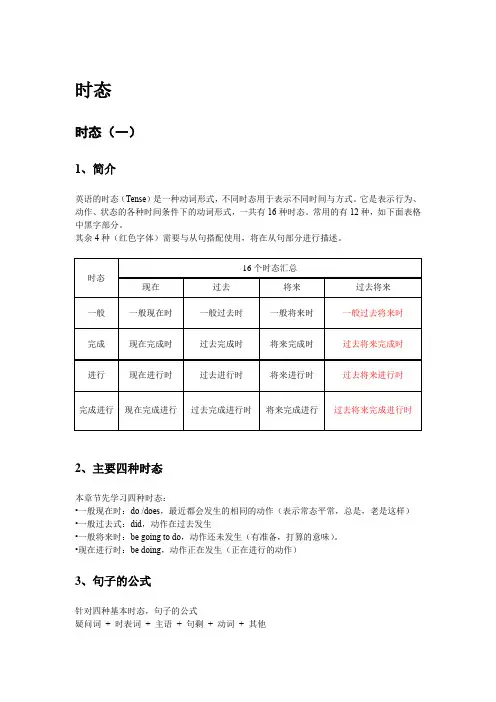
时态时态(一)1、简介英语的时态(Tense)是一种动词形式,不同时态用于表示不同时间与方式。
它是表示行为、动作、状态的各种时间条件下的动词形式,一共有16种时态。
常用的有12种,如下面表格中黑字部分。
其余4种(红色字体)需要与从句搭配使用,将在从句部分进行描述。
2、主要四种时态本章节先学习四种时态:•一般现在时:do /does,最近都会发生的相同的动作(表示常态平常,总是,老是这样)•一般过去式:did,动作在过去发生•一般将来时:be going to do,动作还未发生(有准备,打算的意味)。
•现在进行时:be doing,动作正在发生(正在进行的动作)3、句子的公式针对四种基本时态,句子的公式疑问词+ 时表词+ 主语+ 句剩+ 动词+ 其他【注】主语是动作的发起者,宾语是动作的承受者,句剩只有在一般将来时才用!【例句】1、你刚才去哪儿了?Where did you go?2、你平常都什么时候回来?When do you come back?3、你在吃什么?What are you eating?4、你怎么跟他说的?How did you tell him4、人称相关它it it its its itself他们They them their theirs themselves 【注】此表格格外重要,不要忽视!!!时态(二)1、简介•时态和句子结构清楚后,开始造句,按句子类型分为陈述句和疑问句。
•陈述句又分为肯定句和否定句;疑问句分为特殊疑问句和一般疑问句。
2、一般疑问句与特殊疑问句一般疑问句疑问词时表词主语句剩动词其他Do you know himDid You see herAre you going to eatIs he working特殊疑问句How do you know him Where did You see herWhen are you going to eatHow is he working【注】1、不可以延续的动词(例如:come来,go去,leave离开,arrive到达,start/begin开始)可用现在进行时表将来Are you going to New York = Are you going to go to New York?2、Who和whom的区别:who用于主语或者宾语,whom只能用于宾语。
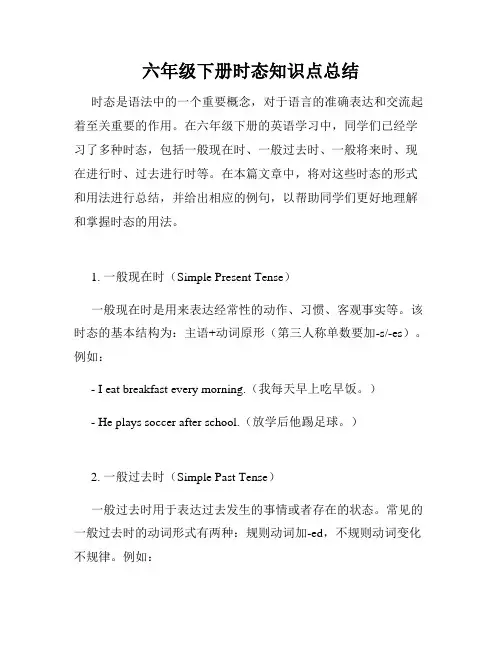
六年级下册时态知识点总结时态是语法中的一个重要概念,对于语言的准确表达和交流起着至关重要的作用。
在六年级下册的英语学习中,同学们已经学习了多种时态,包括一般现在时、一般过去时、一般将来时、现在进行时、过去进行时等。
在本篇文章中,将对这些时态的形式和用法进行总结,并给出相应的例句,以帮助同学们更好地理解和掌握时态的用法。
1. 一般现在时(Simple Present Tense)一般现在时是用来表达经常性的动作、习惯、客观事实等。
该时态的基本结构为:主语+动词原形(第三人称单数要加-s/-es)。
例如:- I eat breakfast every morning.(我每天早上吃早饭。
)- He plays soccer after school.(放学后他踢足球。
)2. 一般过去时(Simple Past Tense)一般过去时用于表达过去发生的事情或者存在的状态。
常见的一般过去时的动词形式有两种:规则动词加-ed,不规则动词变化不规律。
例如:- We visited the museum yesterday.(昨天我们参观了博物馆。
)- She bought a new book last week.(上周她买了一本新书。
)3. 一般将来时(Simple Future Tense)一般将来时常用来表示将来某个时间会发生的动作或事件。
在句子中通常会有表示未来的时间状语,如tomorrow(明天)、next week(下周)等。
一般将来时的基本结构为:will/shall + 动词原形。
例如:- They will go to the beach this weekend.(他们这个周末将去海滩。
)- She shall finish her homework later.(她下一会儿要完成她的作业。
)4. 现在进行时(Present Continuous Tense)现在进行时用来表达此刻正在进行的动作。

小学英语四种时态总结1.一般现在时。
主要描述经常会发生的动作、状态或不变的真理。
句末常出现every day/week/year/Monday , in the morning, 句中常有always, usually, often, sometimes口诀:“经常有每没(美眉^^)总星周”经常:often有:sometimes (记住,“有”不是have,而是“有时”)每:every week/month/year 等没:never 总:always,usually等星周:on Mondays,on Tuesdays等组成:主语+be+名词(形容词)I am a student. He is tall.1. He is in New York with his cousin.他和他的堂兄在纽约。
2. These postcards are great.这些明信片真棒!3. It’s a picture of the Great Wall.这是一张关于长城的明信片。
4.It’s more than twenty thousand kilometers long.它超过两万公里长5.It’s in the east of China.它在中国的东部。
6.There is a Chinatown in New York.纽约有一个唐人街。
7.There are lots of Chinese shops and restaurants there.那里有许多中国商店和餐馆。
8.There are lots of beautiful lakes in China.在中国有许多偏凉漂亮的湖泊。
9.It’s a big family dinner.它是一次大的家庭晚餐。
否定句:在be 后加notI am not a student. He is not tall.1.2.3.4.5.6.7.8.9.疑问句:be 动词提前到第一位。
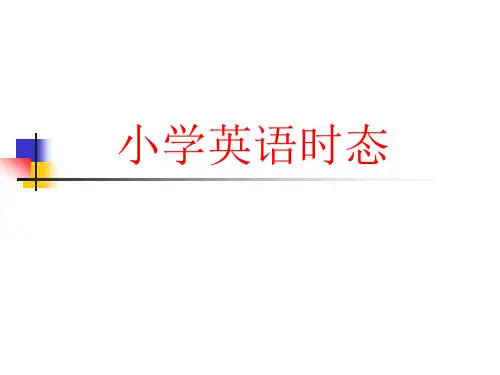
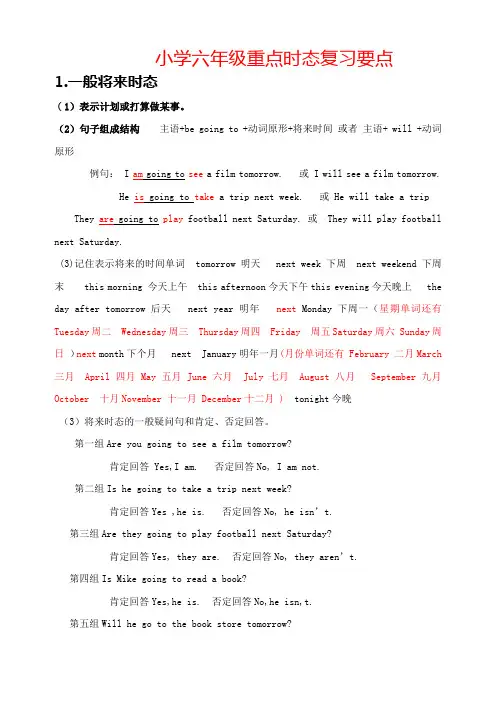
小学六年级重点时态复习要点1.一般将来时态(1)表示计划或打算做某事。
(2)句子组成结构主语+be going to +动词原形+将来时间或者主语+ will +动词原形例句: I am going to see a film tomorrow. 或 I will see a film tomorrow.He is going to take a trip next week. 或 He will take a trip They are going to play football next Saturday. 或 They will play football next Saturday.(3)记住表示将来的时间单词 tomorrow 明天 next week 下周 next weekend下周末 this morning 今天上午 this afternoon今天下午this evening今天晚上 the day after tomorrow 后天 next year 明年next Monday下周一(星期单词还有Tuesday周二 Wednesday周三 Thursday周四 Friday 周五Saturday周六 Sunday周日)next month下个月 next January明年一月(月份单词还有 February 二月March 三月 April四月 May 五月 June六月 July七月 August八月 September九月October 十月November 十一月 December十二月 ) tonight今晚(3)将来时态的一般疑问句和肯定、否定回答。
第一组Are you going to see a film tomorrow?肯定回答 Yes,I am. 否定回答No, I am not.第二组Is he going to take a trip next week?肯定回答Yes ,he is. 否定回答No, he isn’t.第三组Are they going to play football next Saturday?肯定回答Yes, they are. 否定回答No, they aren’t.第四组Is Mike going to read a book?肯定回答Yes,he is. 否定回答No,he isn,t.第五组Will he go to the book store tomorrow?肯定回答Yes, he will. 否定回答No he won’t(4)一般将来时常见的问答对话(黑颜色的为问句,红颜色为答语)What are you going to do tomorrow?你打算明天去做什么?I am going to visit my grandparents tomorrow.我明天打算去拜访外祖父母?Where are you going next week?你下周打算去哪里?I am going to the library next week.我打算下周去图书馆。
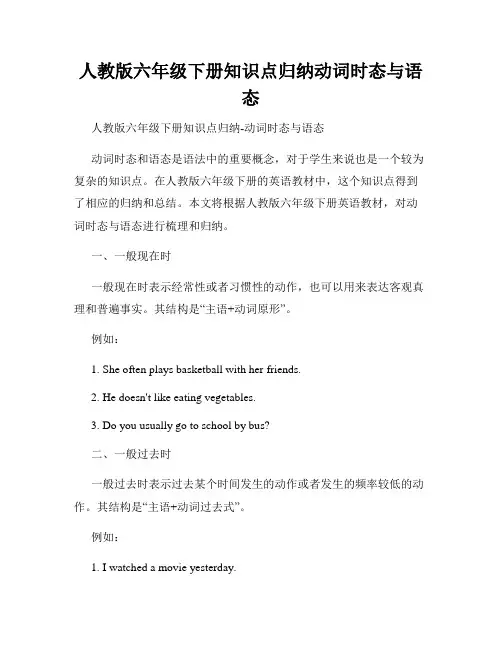
人教版六年级下册知识点归纳动词时态与语态人教版六年级下册知识点归纳-动词时态与语态动词时态和语态是语法中的重要概念,对于学生来说也是一个较为复杂的知识点。
在人教版六年级下册的英语教材中,这个知识点得到了相应的归纳和总结。
本文将根据人教版六年级下册英语教材,对动词时态与语态进行梳理和归纳。
一、一般现在时一般现在时表示经常性或者习惯性的动作,也可以用来表达客观真理和普遍事实。
其结构是“主语+动词原形”。
例如:1. She often plays basketball with her friends.2. He doesn't like eating vegetables.3. Do you usually go to school by bus?二、一般过去时一般过去时表示过去某个时间发生的动作或者发生的频率较低的动作。
其结构是“主语+动词过去式”。
例如:1. I watched a movie yesterday.2. They visited their grandparents last weekend.3. Did you finish your homework?三、一般将来时一般将来时表示将来某个时间要发生的动作或者事件。
其结构是“主语+will+动词原形”。
例如:1. We will have a picnic next Sunday.2. She will go to Beijing next month.3. Will you go to the party with us?四、现在进行时现在进行时表示现阶段正在进行的动作,强调动作正在进行中。
其结构是“主语+be动词+动词ing形式”。
例如:1. I am playing football in the park.2. He is reading a book in the library.3. Are you watching TV now?五、过去进行时过去进行时表示过去某个时间正在进行的动作,也可以表示过去某个时间周围正在进行的动作。
人教版六年级英语四种时态复习四种时态复习一般现在时的基本概念一般现在时表示现在经常反复发生的动作、存在的状态或习惯性的动作的时态。
常见的标志词(时间状语)主要有:every…, sometimes, at…, on Sundays, uauslly often, never, always等。
一般现在时的结构be动词的一般现在时主语+ Be动词+ 其他成分I am a boy.实义动词的一般现在时主语+ 行为动词+ 其他成分We study English.一般现在时的具体形式be动词的一般现在时1.第一人称单数I+amI am a student.2. 第二人称单数you和其他人称复数we/you/they+areYou are a lucky girl.We are students in this school.3. 第三人称单数he/she/it+isShe is my teacher.例题:用be动词的适当形式填空。
1. I from China.2. It very hot today.3. They in the hospital.4. We good students.5. She a beautiful girl.实义动词的一般现在时1.第一、二人称单数I/you和其他人称复数we/you/they+动词原形I get up at 8 o’clock.They go to school everyday.2.第三人称单数he/she/it+实义动词第三人称单数形式It runs fast.He studies hard.例题:用说给单词的适当形式填空。
1. We home every day.(go)2. Trees green in spring.(turn)3. He very hard.(study)4. The boy up at seven O'clock.(get)5. The earth round the sun.(move)补充:主语为第三人称单数形式,谓语动词的变化规则:一般现在时的句型变化be动词的一般现在时肯定句否定句He is a worker. 主语+ be动词+ not + 其他He is not a worker.一般疑问句特殊疑问句Be动词+ 主语+ 其他特殊疑问词+ 一般疑问句-Is he a worker?Where is he?-Yes, he is. / No, he is not.例题:写出下列句子中所缺的be动词,并用肯定及否定形式回答。
小升初专练三:时态专练(二)【现在完成时】一.基本结构have(has) + been + done(动词的现在分词)否定句式have(has) + not + been + done(动词的现在分词) 疑问句式have(has)放在句首二.用法1. 过去发生的动作对现在有影响I have seen the film ,so I know what the story says.2.过去发生的动作持续到现在(还有可能继续发生)The film has been on for 5 minutes.三.延续性动词1. 现在完成时中应使用延续性动词2. 非延续性动词:动作开始既(即)结束四.标志语1.already(已经)2.ever(曾经)3.yet(还,已经)4.just(刚刚)5.ever (曾经)6.before(在……之前)7.since(自从)8.so far(到目前为止)【练一练】1. The Whites many places of interest since they came to China.A. have visitedB. will visitC.visitedD.visit2. How many English books since last year?A. did you readB. have you readC. had you read3.How long have you the book?—For three weeks.A. hadB. keepC. buyD. bought4.you any books?Yes, I them two weeks ago.A. Have: bought; have boughtC. Have, bought; boughtB. Did; buy: boughtD. Did: buy; have bought5. Which place you?A. have; beenB. have: been toC. have: goneD. have; gone to6.I at this school for about two months.A.amB. will beC. have beenD.was7.Have you got any picture books?A. Yes, I have.B. Yes. l don't.C. Yes, I got.8. I've lots of stamps.A. getB. getsC.got二、适当形式填空1. My father isn't here. Maybe he(go) to the supermarket.2. How long you(live) in this town?3. I have(understand).4. He(collect)300 pictures since 5 years ago.5. I have got a letter from my friend and he(get) a present from his friend.6.I (learn) English for three years.7.he(finish) his homework yet?Yes, he(do) it an hour ago.三、句型转换1.Sally has already put her name tag on the suitcase.(改为否定句) Sally put her name tag on the suitcase.2.Jack has watched TV for more than 3 hours.(改成否走句) Jack TV for more than 3 hours?3.I have got two hundred stamps.(对画线部分提问)stamps you got?4.John has done his homework for 4 hours.(改为一般疑问句)John his homework for 4 hours?5.The boy has been to Italy twice.(对划线部分提问)How has the boy been to Italy?。
六年级小学英语下册知识点一、动词时态英语动词时态是指动词在不同时间点上所表达的状态或动作。
在六年级下册英语学习中,我们需要掌握以下几个时态:1. 现在时态(Simple Present Tense)现在时态用来表达频繁发生或普遍真理的动作或状态。
例如:I eat an apple every day.2. 过去时态(Simple Past Tense)过去时态用来表达已经发生、已经结束的动作或状态。
例如:He played soccer yesterday.3. 将来时态(Simple Future Tense)将来时态用来表达将来要发生的动作或状态。
例如:I willvisit my grandparents next week.4. 现在进行时态(Present Continuous Tense)现在进行时态用来表达正在进行的动作。
例如:They are studying English now.5. 过去进行时态(Past Continuous Tense)过去进行时态用来表达过去某个时间点正在进行的动作。
例如:She was reading a book at 8 o'clock yesterday.6. 将来进行时态(Future Continuous Tense)将来进行时态用来表达将来某个时间点正在进行的动作。
例如:We will be watching a movie this time tomorrow.二、情态动词情态动词用来表达人们的意愿、能力、推测等。
在六年级下册英语学习中,我们需要掌握以下几个情态动词:1. can表示能力或许可。
例如:I can swim.2. could表示过去的能力或许可。
例如:He could run fast when he was young.3. may表示许可或推测。
例如:May I go to the bathroom?4. might表示推测或猜测。
小升初英语PEP 版第一轮总复习考点专题精讲专题9—时 态 小学阶段我们需要掌握四种重要时态,包括一般现在时、现在进行时、一般过去时、一般将来时。
我们要掌握这四种时态的动词的变化规则,学会根据不 同的语境和时间使用合适的时态记事,学会根据标志性的时间状语判断句子时态。
考查重点在于选择题、完形填空和改错题等。
类型be 动 词行为动词 结构 例句 结构例句 肯定句 主语+be+其他. I am a boy. 我是个男孩。
主语(第三人称单数)+动词原形(词尾+s/es)+其他. I swim well. 我游泳厉害。
否定句 主语+be+not+其他, He is not a worker. 他不是 工人。
主语+don't/doesn't+动词原形+其他 He doesn't swim well.他游泳不厉害。
一般疑问句 Be+主语+其他? Are you a student? 你是个 学生吗? Do/Does+主语+动词原形+其他? Does he swim well?他游泳厉害吗?特殊疑问句 疑问词+一般疑问句? Where is my bike? 我的自行车在哪里? 疑问词+以do/does 开头的一般疑问句?What do you often do afterclass?课后你经常做什么? ▶▶典型例题例1:She sometimes (help)Ma Hua with her math lesson.【答案】helps【方法点拨】句中关键时间词sometimes 表示偶尔发生的事,与一般现在时连用,与一般现在时连用 的时间状语还有always,usually,never,in the morning,every day,on Sundays 等。
she 是第三人称单数,动词也要发生变化才能与主语保持一致。
构成: be+v.ing 形式类型结构 例句 肯定句 主语+be+v.ing(+其他) I'm doing my homework now.我现在正在做作业。
2020人教版小学六年级英语下册时态知识点一、一般现在时1、一般现在时的功能1.表示事物或人物的特征、状态。
如:Theskyisblue.天空是蓝色的。
2.表示经常性或习惯性的动作。
如:Igetupatsixeveryday.我每天六点起床。
3.表示客观现实。
如:Theearthgoesaroundthesun.地球绕着太阳转。
一般现在时的构成1.be动词:主语+be(am,is,are)+其它。
如:Iamaboy.我是一个男孩。
2.行为动词:主语+行为动词(+其它)。
如:WestudyEnglish.我们学习英语。
当主语为第三人称单数(he,she,it)时,要在动词后加"-s"或"-es"。
如:MarylikesChinese.玛丽喜欢汉语。
2、一般现在时的变化1.be动词的变化。
否定句:主语+be+not+其它。
如:He is not a worker.他不是工人。
一般疑问句:Be+主语+其它。
如:-Are you a student?-Yes.I am./No,I'mnot.特殊疑问句:疑问词+一般疑问句。
如:Where is my bike?2.行为动词的变化。
否定句:主语+don't(doesn't)+动词原形(+其它)。
如:Idon'tlikebread.当主语为第三人称单数时,要用doesn't构成否定句。
如:Hedoesn'toftenplay.一般疑问句:Do(Does)+主语+动词原形+其它。
如:-Doyouoftenplayfootball?-Yes,Ido./No,Idon't.当主语为第三人称单数时,要用does构成一般疑问句。
如:-Doesshegotoworkbybike?-Yes,shedoes./No,shedoesn't.特殊疑问句:疑问词+一般疑问句。
如:Howdoesyourfathergotowork?动词+s的变化规则1.一般情况下,直接加-s,如:cook-cooks,milk-milks2.以s.x.sh.ch.o结尾,加-es,如:guess-guesses, wash-washes, watch-watches,go-goes3.以“辅音字母+y”结尾,变y为i,再加-es,如:study-studies3、一般现在时用法专练:一、写出下列动词的第三人称单数drink________go_______stay________make________look_________have_______pass_______carry____________study_______brush________do_________teach_______二、用括号内动词的适当形式填空。
1.Heoften________(have)dinnerathome.2.DanielandTommy_______(be)inClassOne.3.We_______(notwatch)TVonMonday.4.Nick_______(notgo)tothezooonSunday.5.______they________(like)theWorldCup?6.What_______theyoften_______(do)onSaturdays?7._______yourparents_______(read)newspaperseveryday?8.Thegirl_______(teach)usEnglishonSundays.9.SheandI________(take)awalktogethereveryevening.10.There________(be)somewaterinthebottle.11.Mike_______(like)cooking.12.They_______(have)thesamehobby.13.Myaunt_______(look)afterherbabycarefully.14.Youalways_______(do)yourhomeworkwell.15.I_______(be)ill.I’mstayinginbed.16.She_______(go)toschoolfromMondaytoFriday.17.LiuTao_______(do)notlikePE.18.Thechildoften_______(watch)TVintheevening.19.SuHaiandSuYang_______(have)eightlessonsthisterm.20.-Whatday_______(be)ittoday?HapyⅥ。
④英语(847581894)21:02:45二、现在进行时1.现在进行时表示现在正在进行或发生的动作,也可表示当前一段时间内的活动或现阶段正在进行的动作。
2.现在进行时的肯定句基本结构为be+动词ing.3.现在进行时的否定句在be后加not。
4.现在进行时的一般疑问句把be动词调到句首。
5.现在进行时的特殊疑问的基本结构为:疑问词+ be +主语+动词ing?但疑问词当主语时其结构为:疑问词+ be +动词ing?动词加ing的变化规则1.一般情况下,直接加ing,如:cook-cooking2.以不发音的e结尾,去e加ing,如:make-making, taste-tasting3.如果末尾是一个元音字母和一个辅音字母,双写末尾的辅音字母,再加ing,如:run-running, stop-stopping现在进行时专项练习:一、写出下列动词的现在分词:play________ run__________ swim _________make__________go_________ like________write________ _ski___________read________ have_________ sing ________ dance_________put_________ see________ buy _________ love____________stop_________ sit ________ begin________ shop___________二、用所给的动词的正确形式填空:1.The boy __________________ ( draw)a picture now.2. Listen .Some girls _______________ ( sing)in the classroom .3. My mother _________________ ( cook )some nice foodnow.4. What _____ you ______ ( do ) now?5. Look . They _______________( have) an English lesson .6.They ____________(not ,water) the flowers now.7.Look! the girls ________________(dance )in the classroom .8.What is our granddaughter doing? She _________(listen ) to music.9. It’s5o’clock now. We _____________(have)supper now10.______Helen____________(wash )clothes? Yes ,she is .HapyⅥ。
④英语(847581894)21:03:25三、一般将来时一、概念:表示将要发生的动作或存在的状态及打算、计划或准备做某事。
句中一般有以下时间状语:tomorrow,next day(week,month,year…),soon,the day after tomorrow(后天)等。
二、基本结构:①be going to + do;②will+ do.三、否定句:在be动词(am,is,are)l后加not或情态动词will后加not成won’t。
例如:I’m going to have a picnic this afternoon.→ I’m not going to have a picnic this afternoon.四、一般疑问句:be或will提到句首,some改为any,and改为or,第一二人称互换。
例如:We are going to go on an outing this weekend. → Are you going to go on an outing this weekend?五、对划线部分提问。
一般情况,一般将来时的对划线部分有三种情况。
1.问人。
Who 例如:I’m going to New York soon. →Who’s going to New York soon.2.问干什么。
What … do.例如:My father is going to watch a race with me thisafternoon. →What is your father going to do with you this afternoon.3.问什么时候。
When.例如:She’s going to go to bed at nine. →When is shegoingto bed?六、同义句:be going to = willI am going to go swimming tomorrow(明天). = I will go swimming tomorrow.专项练习:填空。
1.我打算明天和朋友去野炊。
I_____ _______ _________ have a picnic with my friends.I ________ have a picnic with my friends.2.下个星期一你打算去干嘛?我想去打篮球。
What ___________________________________________next Monday?I_______ ______ _____ play basketball.What _________ you do next Monday? I ________ play basketball.3.你妈妈这个周末去购物吗?是,她要去买一些水果。